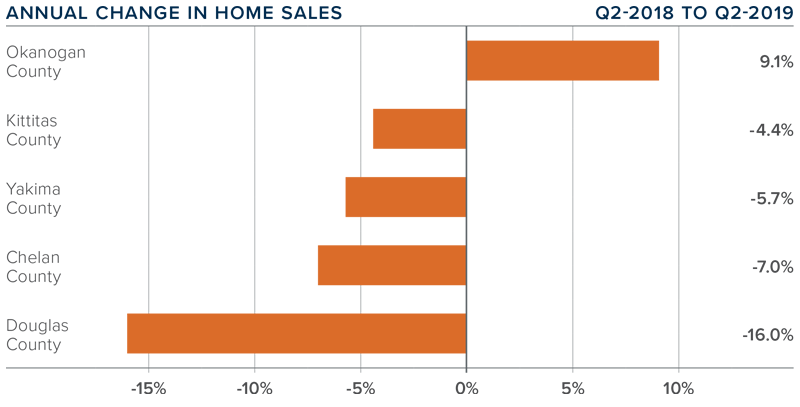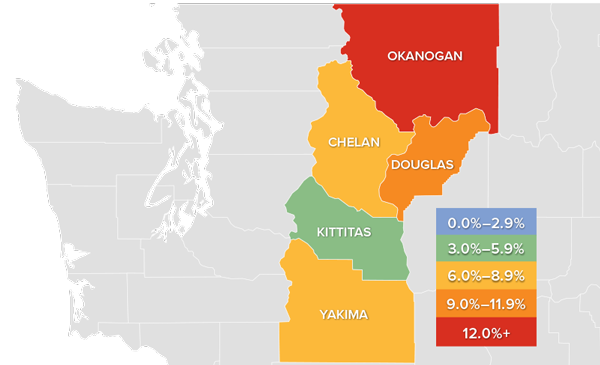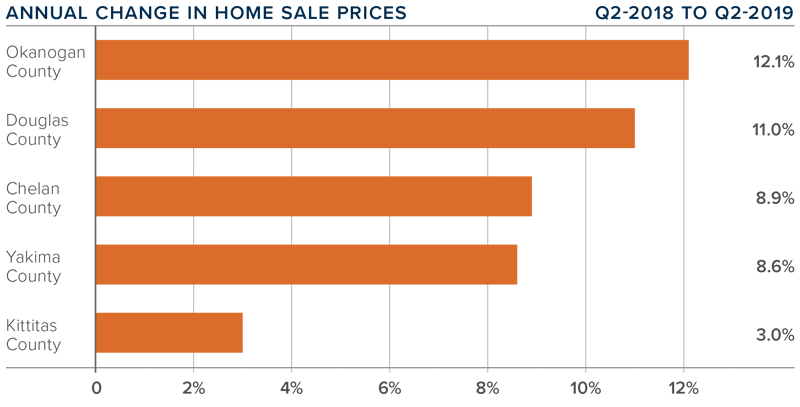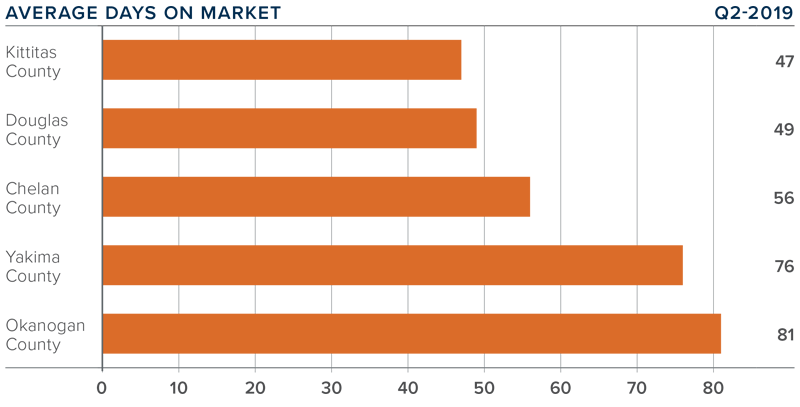The following analysis of the Central Washington real estate market is provided by Windermere Real Estate Chief Economist Matthew Gardner. We hope that this information may assist you with making better-informed real estate decisions. For further information about the housing market in your area, please don’t hesitate to contact your Windermere agent.
ECONOMIC OVERVIEW
Washington State employment jumped back up to an annual growth rate of 2.4% following a disappointing slowdown earlier in the spring. As stated in the first quarter Gardner Report, the dismal numbers earlier this year were a function of the state re benchmarking its data (which they do annually).
The state unemployment rate was 4.7%, marginally up from 4.5% a year ago. On a seasonally adjusted basis, the counties within Central Washington added 3,910 new jobs over the past 12 months, representing a growth rate of 1.7%. The local unemployment rate rose compared to a year ago from 5.3% to 6.1%. However, a majority of the increase can be attributed to a 2.5% increase in the civilian labor force.
HOME SALES
- In the second quarter of 2019, home sales throughout Central Washington fell 5.6% compared to the same period last year, with a total of 1,239 homes sold. Sales were up by a significant 64.1% compared to the first quarter of 2019.
- Sales rose most in Okanogan County, which had an increase of 9.1% over the second quarter of 2018. Sales were lower in all other counties contained in this report, but the contraction was relatively marginal (74 units).
- The number of pending home sales — an indicator of future closings — was up by more than 60% compared to the first quarter, indicating that closings will likely rise in the third quarter of 2019.
- Listing activity in the quarter was generally higher than a year ago, with significant increases in Kittitas and Yakima counties but decreases in the rest of the region. I still expect overall inventory levels to rise modestly as we move through the balance of the year.

HOME PRICES
 Year-over-year, the average home price in the region rose 7.2% to $340,677. Price growth continues to trend well above the long-term average. Inventory growth has not yet been sufficient to meet demand and is pushing prices higher.
Year-over-year, the average home price in the region rose 7.2% to $340,677. Price growth continues to trend well above the long-term average. Inventory growth has not yet been sufficient to meet demand and is pushing prices higher.- Sale prices were 9.8% higher than in the first quarter of this year.
- Prices rose in all counties contained in this report compared to the second quarter of 2018. Okanogan and Douglas counties both saw double-digit price growth.
- The takeaway from this dataset is that significant home-price growth resumed in the quarter, likely because prices were depressed earlier in the year due to inclement weather.

DAYS ON MARKET
- The average number of days it took to sell a home dropped six days compared to the second quarter of 2018.
- The average time it took to sell a home in the region was 62 days, down 20 days from the first quarter of 2019.
- Two markets contained in this report — Okanogan and Yakima — saw days-on-market drop from the same quarter in 2018. It took slightly longer to sell a home in the rest of the region.
- Homes sold fastest in Kittitas County, where it took an average of 47 days to sell a home. The greatest drop in the time it took to sell a home was in Okanogan County, where it took 30 fewer days than in the second quarter of 2018.

CONCLUSIONS
 This speedometer reflects the state of the region’s real estate market using housing inventory, price gains, home sales, interest rates, and larger economic factors.
This speedometer reflects the state of the region’s real estate market using housing inventory, price gains, home sales, interest rates, and larger economic factors.
For the second quarter of 2019, I have moved the needle a little more in favor of sellers. Inventory levels remain low, and prices resumed their upward trajectory. This, in concert with very favorable mortgage rates, bodes well for home sellers.
ABOUT MATTHEW GARDNER
 As Chief Economist for Windermere Real Estate, Matthew Gardner is responsible for analyzing and interpreting economic data and its impact on the real estate market on both a local and national level. Matthew has over 30 years of professional experience both in the U.S. and U.K.
As Chief Economist for Windermere Real Estate, Matthew Gardner is responsible for analyzing and interpreting economic data and its impact on the real estate market on both a local and national level. Matthew has over 30 years of professional experience both in the U.S. and U.K.
In addition to his day-to-day responsibilities, Matthew sits on the Washington State Governors Council of Economic Advisors; chairs the Board of Trustees at the Washington Center for Real Estate Research at the University of Washington; and is an Advisory Board Member at the Runstad Center for Real Estate Studies at the University of Washington where he also lectures in real estate economics.
 Facebook
Facebook
 X
X
 Pinterest
Pinterest
 Copy Link
Copy Link



